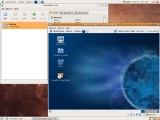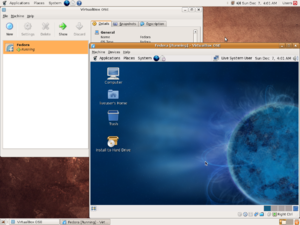
Full virtualization
Encyclopedia

Computer science
Computer science or computing science is the study of the theoretical foundations of information and computation and of practical techniques for their implementation and application in computer systems...
, full virtualization is a virtualization technique used to provide a certain kind of virtual machine
Virtual machine
A virtual machine is a "completely isolated guest operating system installation within a normal host operating system". Modern virtual machines are implemented with either software emulation or hardware virtualization or both together.-VM Definitions:A virtual machine is a software...
environment, namely, one that is a complete simulation of the underlying hardware. Full virtualization requires that every salient feature of the hardware be reflected into one of several virtual machine
Virtual machine
A virtual machine is a "completely isolated guest operating system installation within a normal host operating system". Modern virtual machines are implemented with either software emulation or hardware virtualization or both together.-VM Definitions:A virtual machine is a software...
s – including the full instruction set, input/output operations, interrupts, memory access, and whatever other elements are used by the software that runs on the bare machine
Bare machine
Bare Machine, in computer parlance, means a computer without its operating system. Modern operating systems evolved through various stages, from elementary to the present day complex, highly sensitive real-time systems. In the very first stage of computing there was nothing like an Operating System...
, and that is intended to run in a virtual machine. In such an environment, any software capable of execution on the raw hardware can be run in the virtual machine and, in particular, any operating systems. The obvious test of virtualization is whether an operating system intended for stand-alone use can successfully run inside a virtual machine.
Other forms of platform virtualization allow only certain or modified software to run within a virtual machine. The concept of full virtualization is well established in the literature, but it is not always referred to by this specific term; see platform virtualization for terminology.
An important example of full virtualization was that provided by the control program of IBM's CP/CMS
CP/CMS
CP/CMS was a time-sharing operating system of the late 60s and early 70s, known for its excellent performance and advanced features...
operating system. It was first demonstrated with IBM's CP-40
IBM CP-40
CP-40 was a research precursor to CP-67, which in turn was part of IBM's then-revolutionary CP[-67]/CMS – a virtual machine/virtual memory time-sharing operating system for the IBM System/360-67, and the parent of IBM's VM family. CP-40 ran multiple instances of client operating systems...
research system in 1967, then distributed via open source
Open source
The term open source describes practices in production and development that promote access to the end product's source materials. Some consider open source a philosophy, others consider it a pragmatic methodology...
in CP/CMS in 1967-1972, and re-implemented in IBM's VM family
VM (operating system)
VM refers to a family of IBM virtual machine operating systems used on IBM mainframes System/370, System/390, zSeries, System z and compatible systems, including the Hercules emulator for personal computers. The first version, released in 1972, was VM/370, or officially Virtual Machine Facility/370...
from 1972 to the present. Each CP/CMS user was provided a simulated, stand-alone computer. Each such virtual machine had the complete capabilities of the underlying machine, and (for its user) the virtual machine was indistinguishable from a private system. This simulation was comprehensive, and was based on the Principles of Operation manual for the hardware. It thus included such elements as instruction set, main memory, interrupts, exceptions, and device access. The result was a single machine that could be multiplexed among many users.
Full virtualization is only possible given the right combination of hardware and software
Popek and Goldberg virtualization requirements
The Popek and Goldberg virtualization requirements are a set of conditions sufficient for a computer architecture to support system virtualization efficiently. They were introduced by Gerald J. Popek and Robert P. Goldberg in their 1974 article "Formal Requirements for Virtualizable Third...
elements. For example, it was not possible with most of IBM's System/360
System/360
The IBM System/360 was a mainframe computer system family first announced by IBM on April 7, 1964, and sold between 1964 and 1978. It was the first family of computers designed to cover the complete range of applications, from small to large, both commercial and scientific...
series with the exception being the IBM System/360-67; nor was it possible with IBM's early System/370
System/370
The IBM System/370 was a model range of IBM mainframes announced on June 30, 1970 as the successors to the System/360 family. The series maintained backward compatibility with the S/360, allowing an easy migration path for customers; this, plus improved performance, were the dominant themes of the...
system until IBM added virtual memory hardware to the System/370 series in 1972.
Similarly, full virtualization was not quite possible with the x86 platform until the 2005-2006 addition of the AMD-V and Intel VT-x extensions (see x86 virtualization
X86 virtualization
In computing, x86 virtualization is the facility that allows multiple operating systems to simultaneously share x86 processor resources in a safe and efficient manner, a facility generically known as hardware virtualization...
). Many platform virtual machines for the x86 platform came very close and claimed full virtualization even prior to the AMD-V and Intel VT-x additions. Examples include Adeos
Adeos
Adeos is a nanokernel hardware abstraction layer or a hypervisor that operates between computer hardware and the operating system that runs on it. It is distinct from other nanokernels, in that it is not just a low level layer for an outer kernel...
, Mac-on-Linux
Mac-on-Linux
Mac-on-Linux is an open source virtual machine program for running Mac OS on PowerPC computers running Linux. It can also be used to run another instance of another PowerPC-based operating system ....
, Parallels Desktop for Mac
Parallels Desktop for Mac
Parallels Desktop for Mac by Parallels, Inc., is software providing hardware virtualization for Macintosh computers with Intel processors.-Overview:Parallels, Inc...
, Parallels Workstation
Parallels Workstation
Parallels Workstation is the first commercial software product released by Parallels, Inc., a developer of desktop and server virtualization software...
, VMware Workstation
VMware Workstation
VMware Workstation is a virtual machine software suite for x86 and x86-64 computers from VMware, a division of EMC Corporation, which allows users to set up multiple x86 and x86-64 virtual machines and use one or more of these virtual machines simultaneously with the hosting operating system...
, VMware Server
VMware Server
VMware Server is a free-of-charge virtualization-software server suite developed and supplied by VMware, Inc....
(formerly GSX Server), VirtualBox
VirtualBox
Oracle VM VirtualBox is an x86 virtualization software package, originally created by software company Innotek GmbH, purchased by Sun Microsystems, and now developed by Oracle Corporation as part of its family of virtualization products...
, Win4BSD, and Win4Lin Pro
Win4Lin
Win4Lin was a proprietary software application for Linux which allowed users to run a copy of Microsoft Windows 95, 98, Me, 2000 or XP applications on their Linux desktop.-Overview:...
. VMware, for instance, employs a technique called binary translation
Binary translation
In computing, binary translation is the emulation of one instruction set by another through translation of code. Sequences of instructions are translated from the source to the target instruction set...
to automatically modify x86 software on-the-fly to replace instructions that "pierce the virtual machine" with a different, virtual machine safe sequence of instructions; this technique provides the appearance of full virtualization.
A key challenge for full virtualization is the interception and simulation of privileged operations, such as I/O instructions. The effects of every operation performed within a given virtual machine must be kept within that virtual machine – virtual operations cannot be allowed to alter the state of any other virtual machine, the control program, or the hardware. Some machine instructions can be executed directly by the hardware, since their effects are entirely contained within the elements managed by the control program, such as memory locations and arithmetic registers. But other instructions that would "pierce the virtual machine" cannot be allowed to execute directly; they must instead be trapped and simulated. Such instructions either access or affect state information that is outside the virtual machine.
Full virtualization has proven highly successful for:
- sharing a computer system among multiple users;
- isolating users from each other (and from the control program);
- emulating new hardware to achieve improved reliability, security and productivity.
See also
- Platform virtualization
- CP/CMSCP/CMSCP/CMS was a time-sharing operating system of the late 60s and early 70s, known for its excellent performance and advanced features...
- Popek and Goldberg Virtualization RequirementsPopek and Goldberg virtualization requirementsThe Popek and Goldberg virtualization requirements are a set of conditions sufficient for a computer architecture to support system virtualization efficiently. They were introduced by Gerald J. Popek and Robert P. Goldberg in their 1974 article "Formal Requirements for Virtualizable Third...
- Hardware-assisted virtualization
- Partial virtualization
- ParavirtualizationParavirtualizationIn computing, paravirtualization is a virtualization technique that presents a software interface to virtual machines that is similar but not identical to that of the underlying hardware....
- Comparison of platform virtual machines
- OS level virtualization
- LPARLPARA logical partition, commonly called an LPAR, is a subset of computer's hardware resources, virtualized as a separate computer. In effect, a physical machine can be partitioned into multiple logical partitions, each hosting a separate operating system....
- PR/SMPR/SMPR/SM is a type-1 Hypervisor that allows multiple logical partitions to share physical resources such as CPUs, I/O channels and direct access storage devices...
- HypervisorHypervisorIn computing, a hypervisor, also called virtual machine manager , is one of many hardware virtualization techniques that allow multiple operating systems, termed guests, to run concurrently on a host computer. It is so named because it is conceptually one level higher than a supervisory program...
- I/O VirtualizationI/O virtualizationInput/output virtualization is a methodology to simplify management, lower costs and improve performance of servers in enterprise environments...
- Virtual machineVirtual machineA virtual machine is a "completely isolated guest operating system installation within a normal host operating system". Modern virtual machines are implemented with either software emulation or hardware virtualization or both together.-VM Definitions:A virtual machine is a software...

